My trip to Thailand on November 1, 2021 coincided with the first day of Thailand’s effort to open to the world under the new Thailand Pass no-quarantine program. Even though the trip involved a lot of unknowns, one guarantee was that the flight in first class on the Japan Airlines flight from Chicago to Tokyo would be an amazing experience. Having been 18 months since my last trans-Pacific flight, this one flight promised to make the whole trip worthwhile.
Booking The Flights
It took 180,000 American Airlines frequent flyer miles to book the flights for this trip on the American Airlines website. The miles were good for domestic first class on American Airlines from Charlotte, NC to Chicago, IL; Japan Airlines first class from Chicago, IL to Tokyo, Japan and business class from Tokyo to Bangkok, Thailand; Japan Airlines business class from Bangkok to Tokyo and Tokyo to New York; and American Airlines domestic first class from New York to Charlotte.
Downgrading the flight to Tokyo from first class to business class would have saved 40,000 miles. Using the extra miles was more than worth it for the first-class experience. There is a big difference between first class and business class just as there is a big difference between business class and economy.
180,000 airline miles sounds like a lot. It is a total that is easily reachable when you consider that there are at least 34 different ways to acquire American Airlines miles including sign-up bonuses for and spend on American Airlines personal and small-business credit cards from Citibank and Barclays, hotel stays, dinning out and food delivery, purchases through the American Airlines eShopping portal, car rentals, and probably the least productive methods, buying miles from American or actually flying American or one of its partner airlines. These days, calling airline miles “frequent flyer miles” is a misnomer.
Japan Airlines Flight 8009 Chicago, IL (ORD) To Tokyo, Japan (NRT)
Flight Dates: November 1 and 2, 2021
Equipment: Boeing 777-300ER
Great Circle Distance: 6,274mi (10,097km, 5,452nm)
Scheduled Flight Time: 13hours and 35 minutes
Class of Service: International First Class!!! 😍
As reported previously, I missed the original flight from Charlotte to Chicago and was fortunate to be rebooked on the next flight. That flight arrived at ORD Terminal 3 Gate H5 at just after 10:00. JL Flight 8009 was departing from Terminal 3 Gate K19 at 11:20. It was only a 10-minute walk to Gate K19 via the connecting corridor between the H and K Gates. American Airlines has a very nice Flagship Lounge located on the connecting corridor that Japan Airlines uses for first and business class passengers, but there was no time to stop and it was closed because of the pandemic anyway.
Covid travel restrictions place extra burdens on airline personnel. At check in and before boarding, they must verify that each passenger has satisfied all of the travel requirements imposed by their ultimate destination. In addition to their other duties, the Japan Airlines gate agents checked my passport and copies of my Thailand Certificate of Entry, Vaccine Certificate, and negative PCR Covid-19 test and helped me download the Thailand+ app, which Thai authorities want tourists to have on their phones. The agents accomplished all of the passenger checks and started boarding the flight on time 10:50.
Japan Airlines 777-300ER

I had great expectations for this flight in first class, but flying on Japan Airlines’ 777-300ERs with only 244 seats total is an delightful experience in every class of service.

First Class Cabin And Seat
On this aircraft, Japan Airlines has nice touches for each cabin but saves the best for first – first class that is.

First class consists of eight JAL Suites arranged 1-2-1. As would be expected, each suite has direct access to an aisle and a seat that converts to a flat bed with a maximum width of 33 inches (84cm) and a maximum length of 78 inches (199cm).
I selected Suite 2K for this flight. It is a window suite on the starboard (right) side in the second row. As a right-handed person, I usually choose seats on the right side of the plane because they normally have seat and audio/visual controls and a writing surface on the right. That is the case with Suite 2K.


This seat is essentially the same as the first-class seat I enjoyed in 2015 on another Japan Airlines flight. It bothered me not in the least that this is not the newest first class seat in the sky or that it doesn’t have a door. In fact, I like the classic looks, features, and comfort of this suite just fine.
Seat controls are excellent. The seat can position itself in three preset positions with the touch of a button. There are also separate controls for positioning the supports for the head and neck, torso, and lower legs. The lumbar support has a massage function and can be moved forward, back, up, and down. The entire seat can be moved forward and back about three feet.

This suite is big enough to seat two, and it does. The large ottoman can be used as a second seat so another passenger in first class can join for dining or conversation.
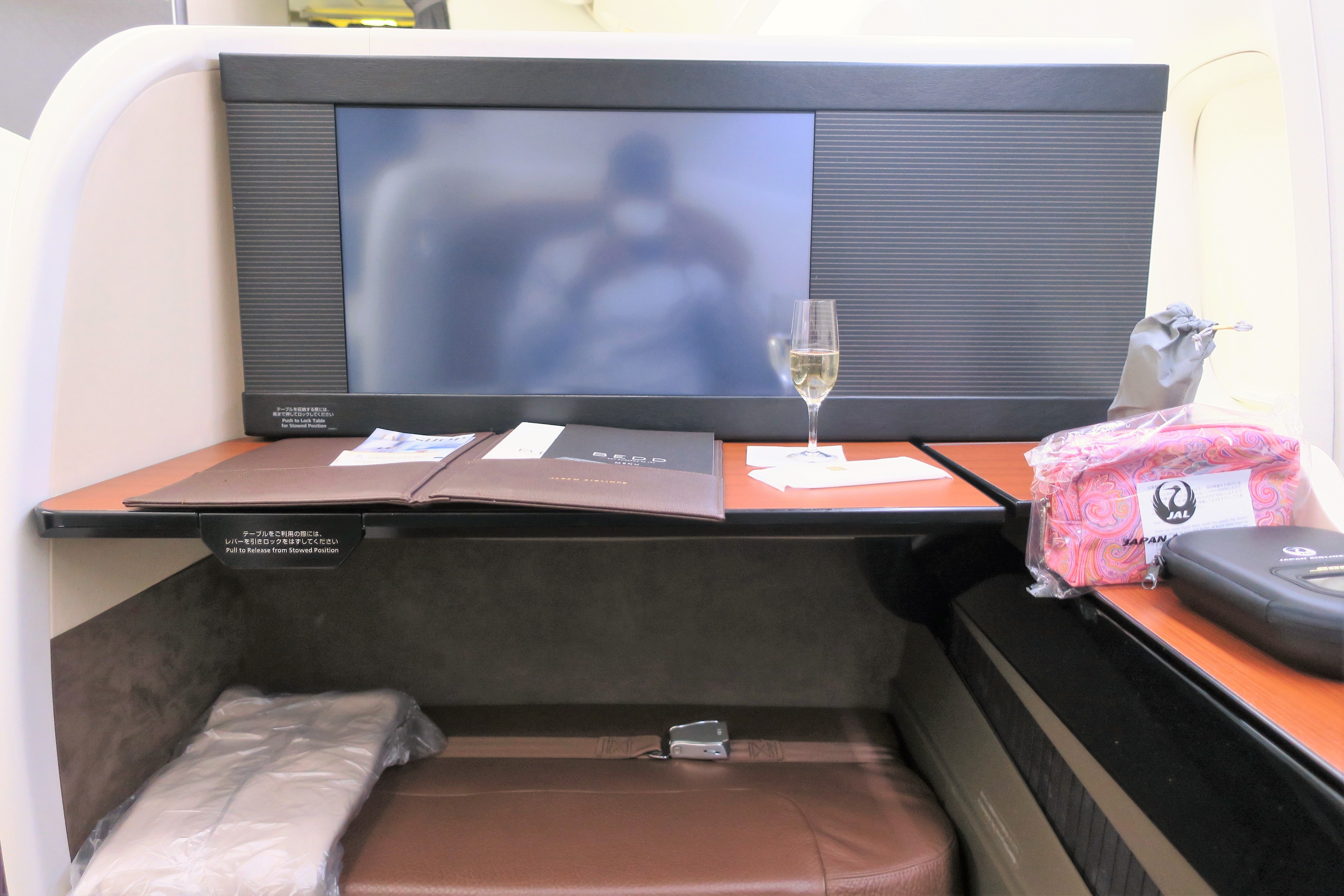
What’s the difference, you ask, between a seat in first class and a business-class seat? First class seats are bigger and fancier than seats in business class. Having a large ottoman for resting the feet is another one of the features that distinguishes a first class seat. In business class, most seats (although not the Apex Suites on this aircraft) require fitting your feet and lower legs into a small cubbyhole under the console of the seat in front.
First class seats also usually have oodles of secure, covered storage. The JAL Suite excels in this regard.


You can even store a back pack under the ottoman.

Privacy was not an issue especially because there was only one other passenger in first class. He was sitting in Suite 1A on the opposite side of the cabin.
Departure
The head flight attendant and one dedicated to first class introduced themselves while I was settling in. They offered champagne, which I gladly accepted, and said not to hesitate to ask for anything to make the flight enjoyable.
The door closed at 11:15. Right after the door closed, the flight attendants gathered at the front of each cabin to perform their traditional bow to the passengers. On many non-Asian airlines, flight attendants act like the passengers should bow to them. Pushback from the gate occurred as scheduled at 11:20 on the dot.

Climbing out, the captain turned north to our course to Tokyo. I glanced down and had a good view of Palwaukee Executive Airport, which was where I’d had an interesting experience on a Civil Air Patrol mission about 30 years earlier.

Amenities
Japan Airlines first class passengers enjoy a plethora of amenities such as Bose noise-cancelling headphones, an amenity kit, a blanket for use while sitting, slippers, Shiseido personal care set, and free wifi throughout the flight.

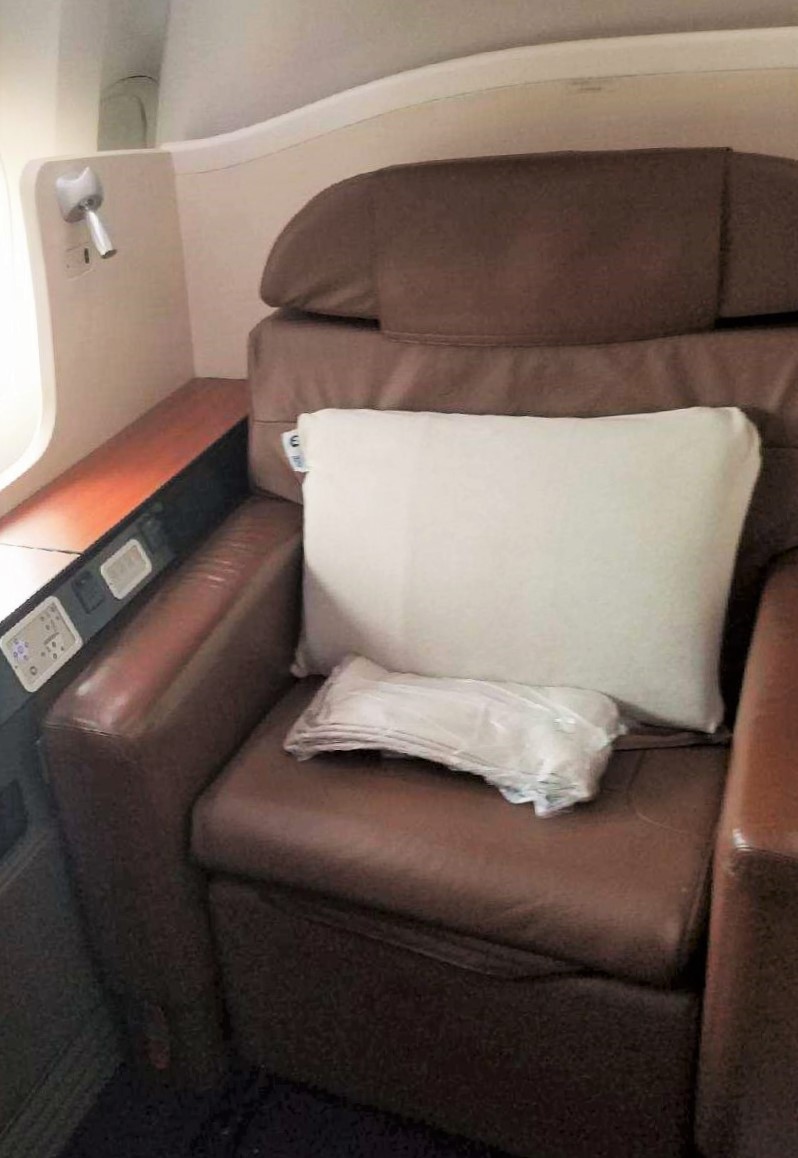
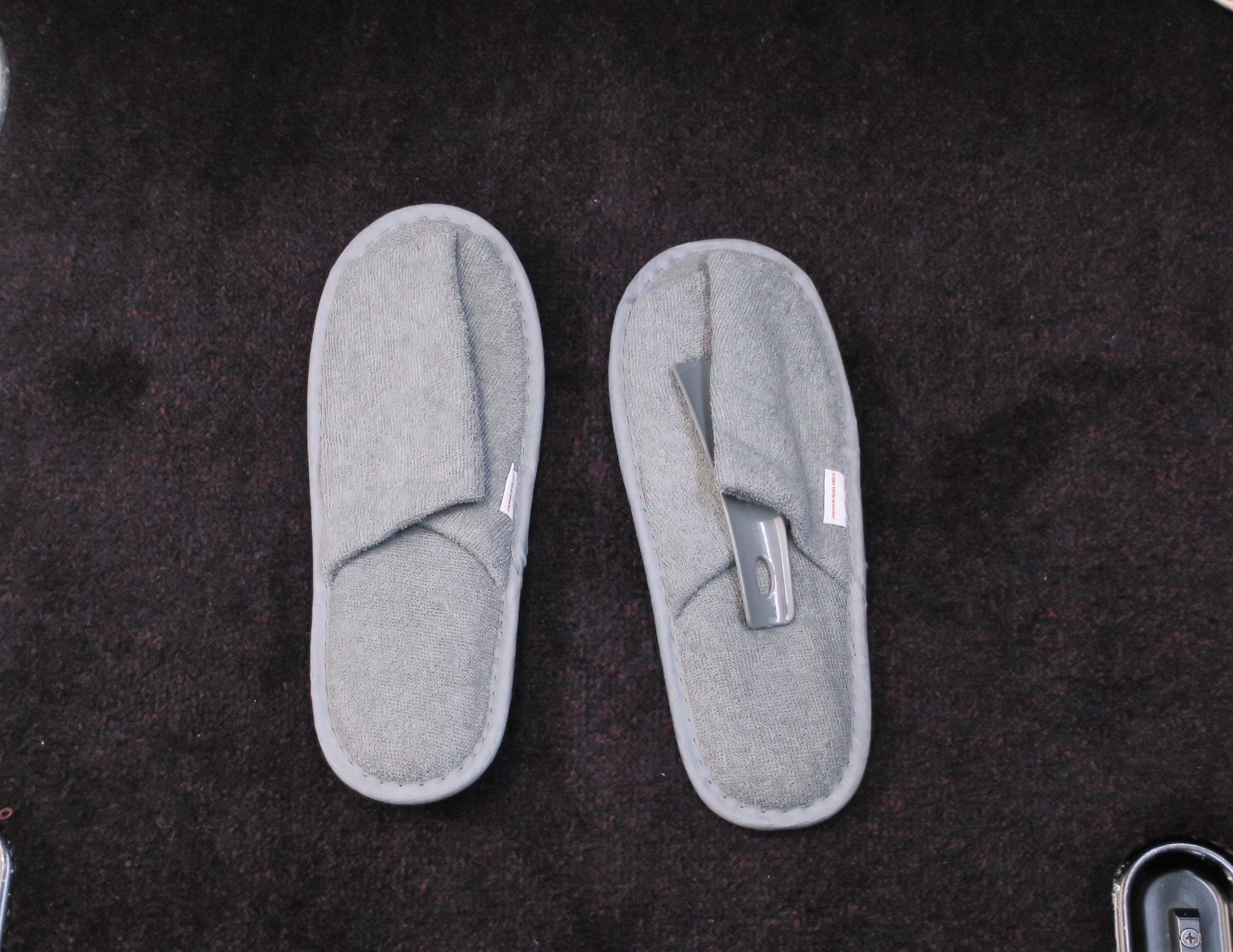

The amenity kit comes with toothbrush set, mouth wash, earplugs, eye mask, hand & body cream, perfume, lip balm, brush, moisture mask, and pocket tissue.
Inflight Service
The inflight service of the Japan Airlines flight attendants along with a terrific selection of high-quality food and beverages are some of the primary reasons for Japan Airlines consistently being ranked among the top 5 airlines in the world.
Menus
The extensive menus were presented in a leather portfolio that was at the seat at boarding. The first meal service is always the largest meal, except on red-eye flights where most passengers will prefer sleep after takeoff. There were menus for a Japanese meal and a Western meal for the first meal plus menus for Japanese and Western set plates and a la carte choices for later in the flight.
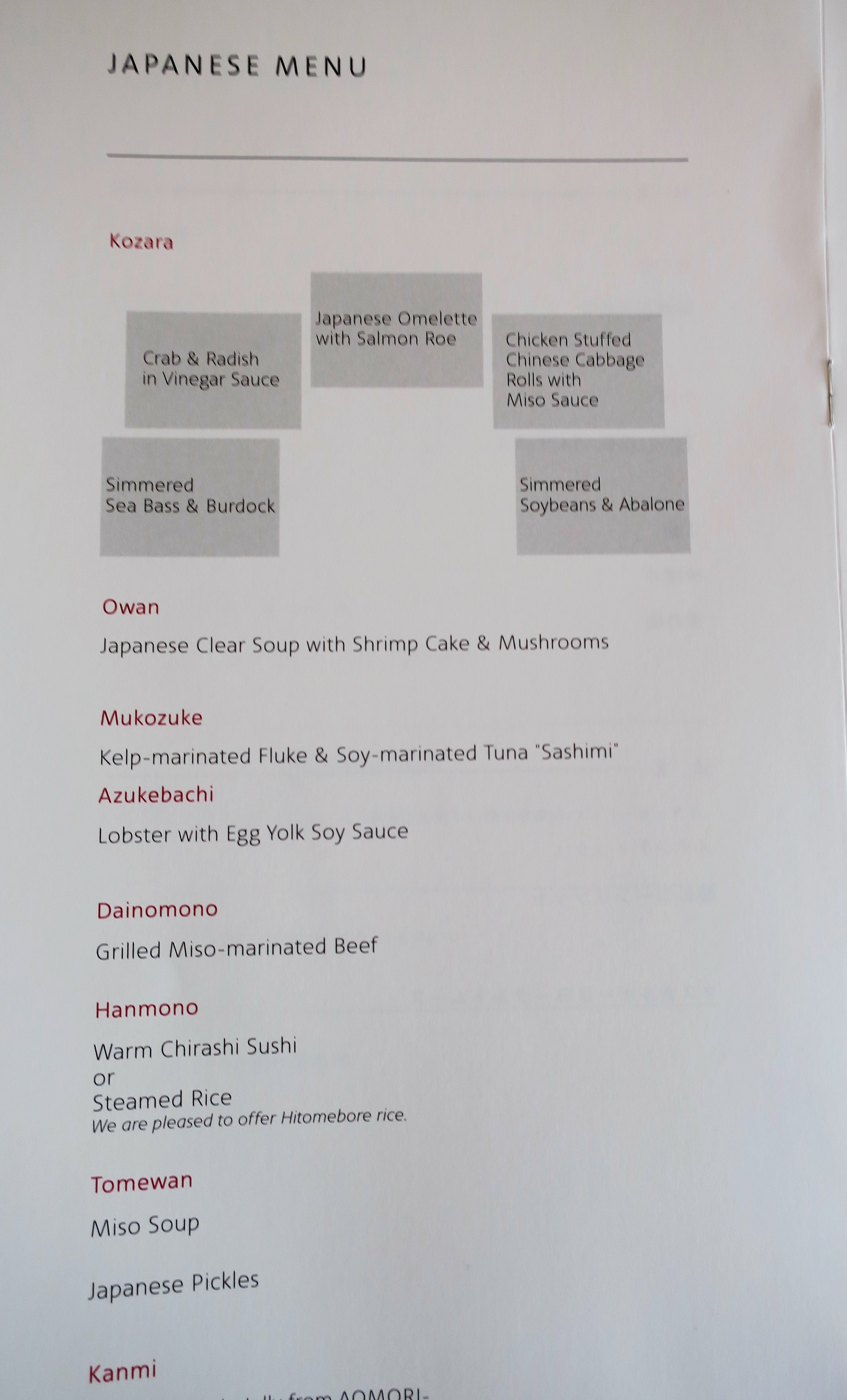
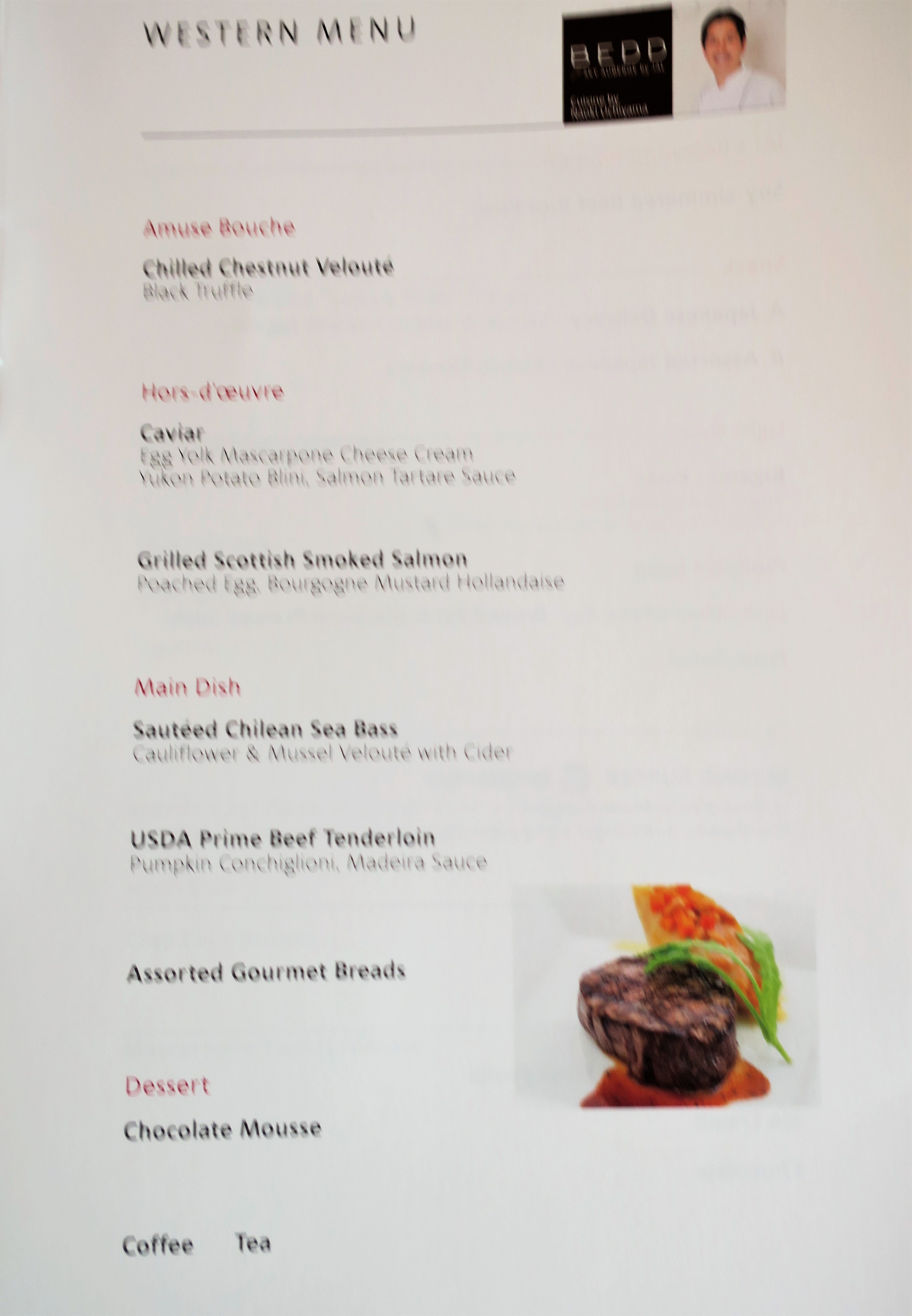


Champagne and Wine
Japanese Sake and Sochu
Other Alcoholic Beverages

Non-alcoholic Beverages
I choose a Japanese meal on the Japan Airlines website shortly after booking. The rule of thumb when ordering airline meals is to go with the cuisine of the country of departure. The theory being that local caterers will do better with local dishes than recipes from a foreign country. I ignored this guideline in order to have a Japanese meal in first class. Surely the Japan Airlines caterers in Chicago would do an outstanding job with the Japanese menu, geography notwithstanding.
First Meal Service
The first meal service began with drinks. My choice was 21-year-old Chivas Regal Royal Salute to go with the appetizer.


I asked for Hiroki sake to accompany the Kozara.

Kozara


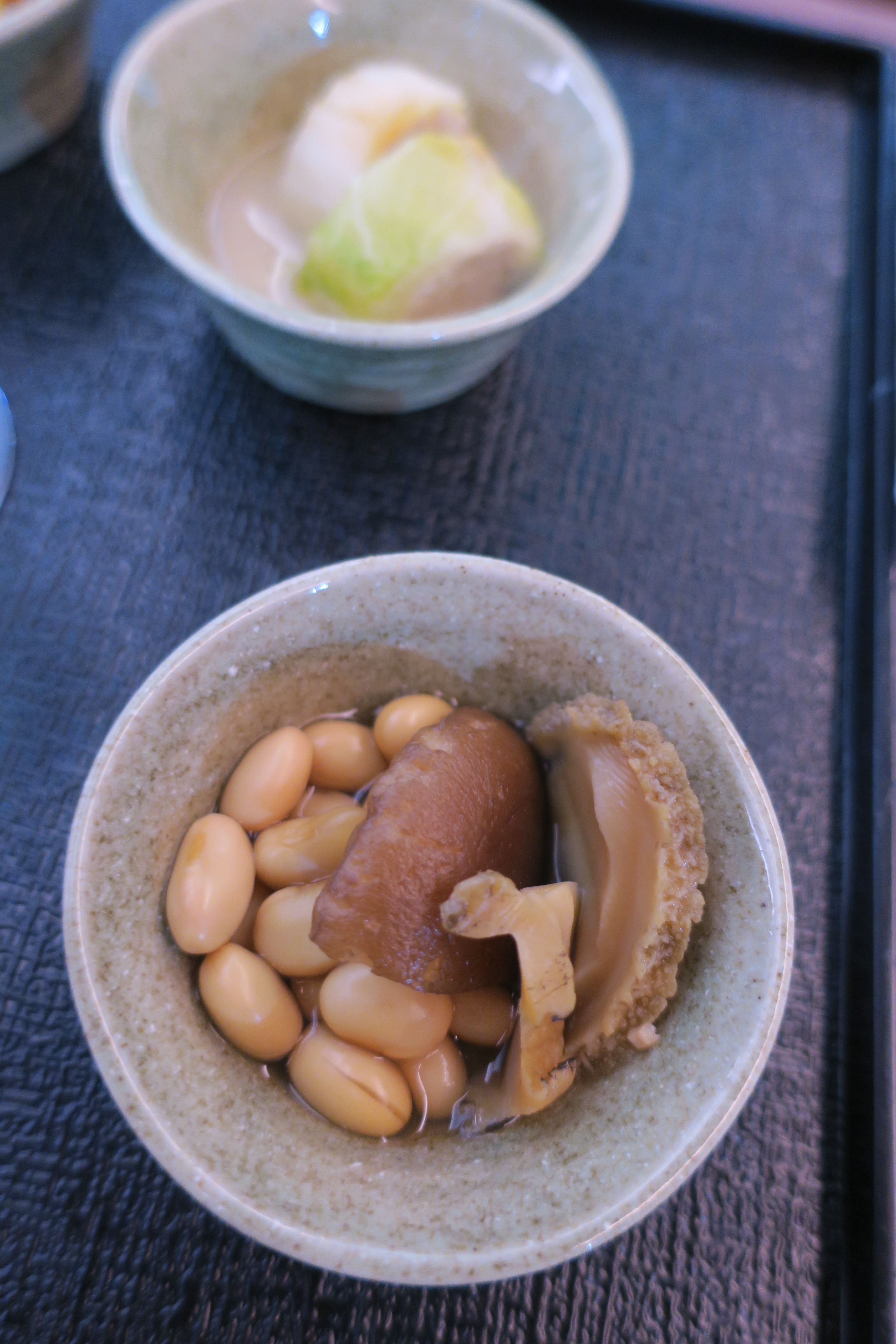

Owan

I switched to Isojiman sake after the Owan course.

Mukosuke and Azukebachi

Dianomono, Hanmomo, and Tomewan
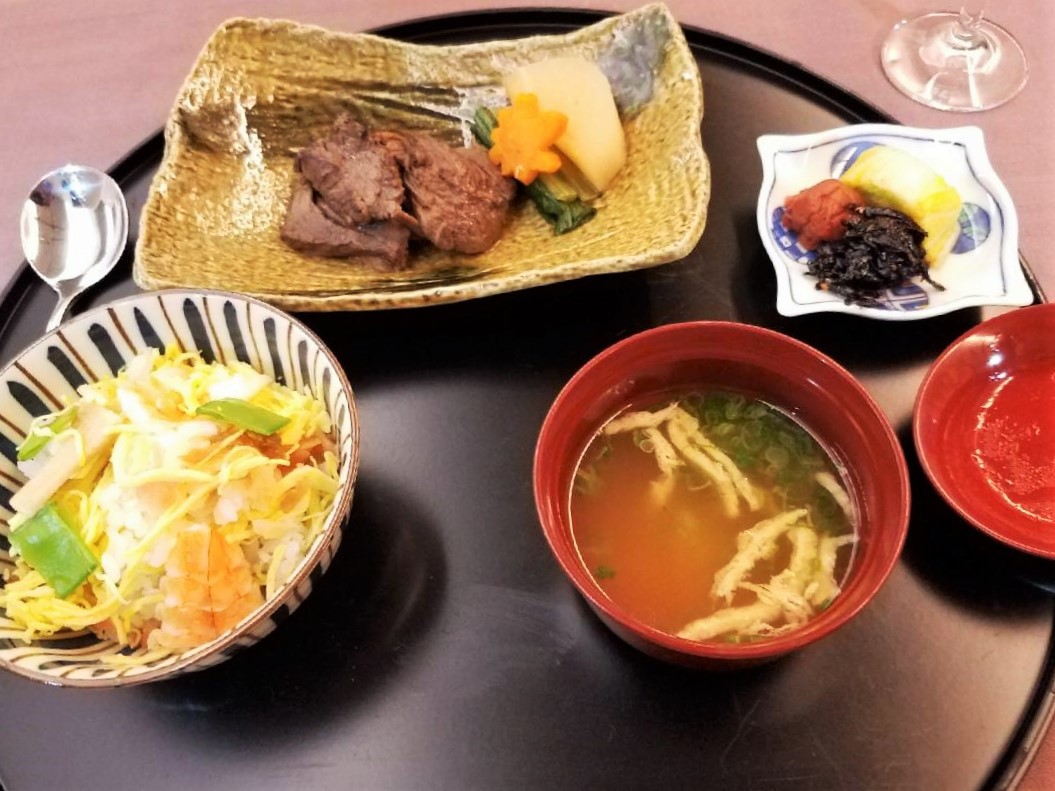
Kanmi

Everything about the meal including the sake was outstanding, and the flight attendants served it with grace and style. I like the fact that Japanese meals often come in multiple courses and courses usually offer two or three different components. It is a great way to try many different delicacies at one sitting.
Japan Airlines Inflight Entertainment System (IFE)
After diner, I tried, without success, to find a good movie to watch. The JAL Mooove! library is woefully short on the latest movies and there isn’t much in the way of oldies and classics either. The IFE system was the biggest and only disappointment of the flight. It is puzzling. Japan Airlines could easily do much better.
I found a movie that was reasonably entertaining and watched it on the outstanding 23-inch video monitor. The Bose noise-cancelling headsets delivered excellent audio quality as would be expected.
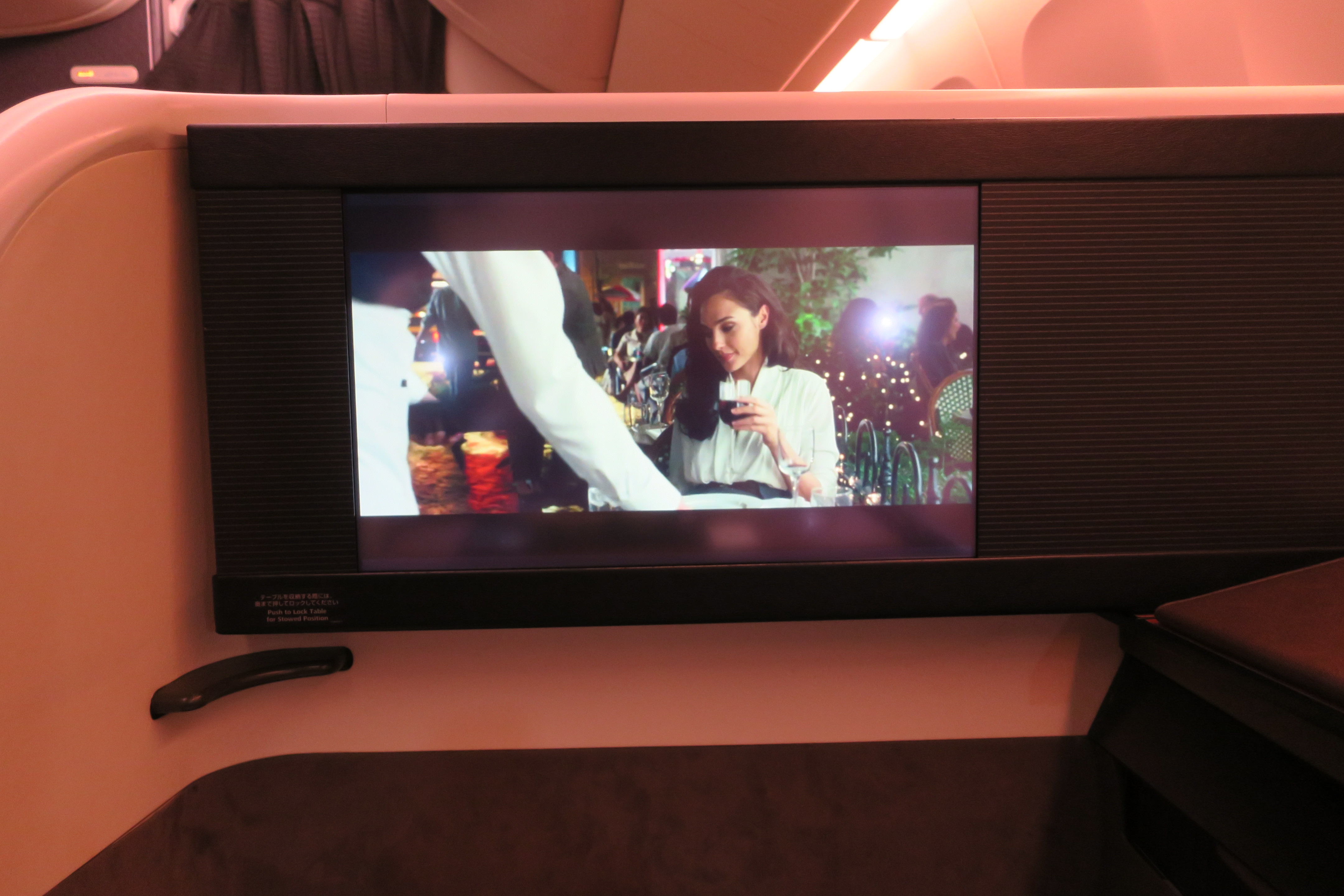
Bedtime
After the movie, I changed into the loungewear Japan Airlines supplies for first class passengers. and asked the attendant to make the bed.

I used to scoff at the idea of wearing pajamas on a plane — that is until I tried it for the first time several years ago. PJs make an enormous difference in onboard comfort whether sleeping, relaxing or working, but the improvement in sleep comfort is especially noticeable. I mean no one prefers sleeping in their clothes at home and a plane is no different!
I changed in the lavatory. The attendant provided hangers for my clothes and stored them in a closet. As you will later see, there is no concern about changing clothes in the bathroom because, on Japan Airlines, the facilities are always clean as a whistle.
When I emerged from the lavatory, the attendant had the bed made. Adding a mattress to the seat is another enhancement in first class that makes sleeping on a plane easy and pleasant.

It turned out that I had two suites on this flight. With only one other passenger in first class, the attendant converted the suite across the aisle, 2G, into my bedroom. One seat for sitting and one seat for sleeping. Perfect!

Although pjs, a mattress, a comfy pillow and a warm quilt make sleeping a breeze, in first class I prefer to remain awake as much as possible to enjoy the experience. As requested, the attendant dropped by three hours later to ensure I was awake.
After waking I couldn’t resist sampling more of the delicious cuisine.

Later, assorted cheese, fresh fruit and ice cream and the best part, 30-year-old Graham’s Tawny port.
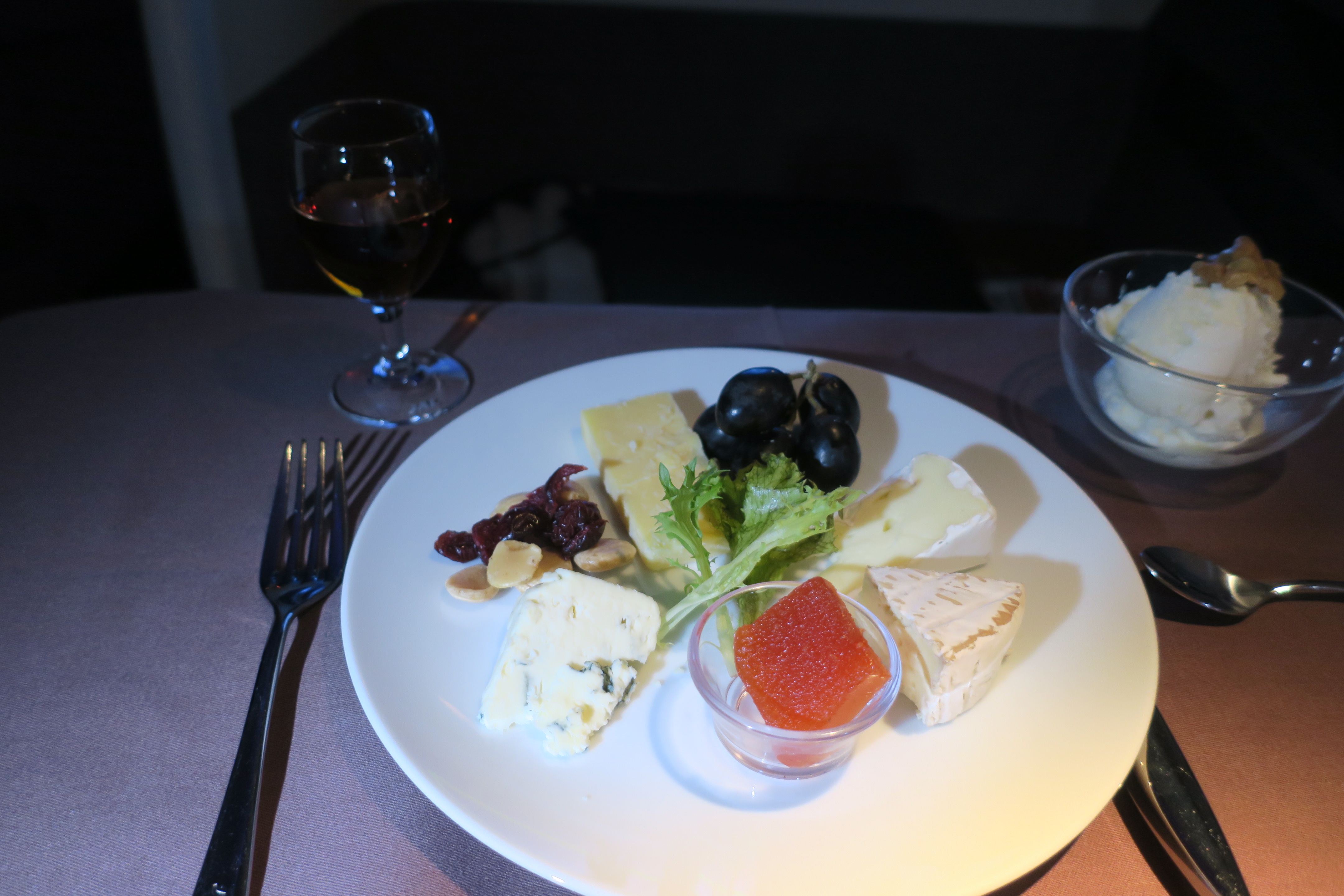
Lavatories
There are two regular-sized bathrooms in the 777-300ER first-class cabin. With only two passengers in first class, there was never any waiting for a bathroom, and the flight attendants had no problem keeping them clean. A larger bathroom suitable for someone with disabilities is located in the cabin for business class.



Wifi
First class passengers receive a card with a code for free access to the onboard wifi.

I had difficulty connecting because the online forms for connecting were in Japanese. A flight attendant was kind enough to help but the system disconnected me whenever the computer went to sleep. I usually don’t pay for onboard internet so it was nice to be connected inflight for a change. The card saved me about $19.
Arrival
All good things come to an end, and this flight was no exception in spite of being described as a “non stop” flight (ha ha!). The captain announced our approach to Tokyo Narita International Airport (NRT) over the Pacific about 45 minutes before landing. There was some sadness while changing back to street clothes, packing up and stowing gear. It is nice to be spoiled by 12 plus hours of being pampered and wined and dined.

We landed at 14:08 and parked at Gate 95 in the Terminal 2 Satellite at 14:18 on November 2, 2021.
Even though I would be taking a flight to Bangkok, Thailand and not entering Japan officially, I wondered about the Covid procedures that Japan had in store for connecting passengers. The next post about this trip to Thailand will cover the three-hour layover at NRT and the Japan Airlines First Class Lounge.

Final Thoughts
Thanks for getting through this lengthy post. This flight lived up to my high expectations for Japan Airlines and an international first class experience. I wish everyone could have that experience at least once. Which part of this flight would you have enjoyed most?
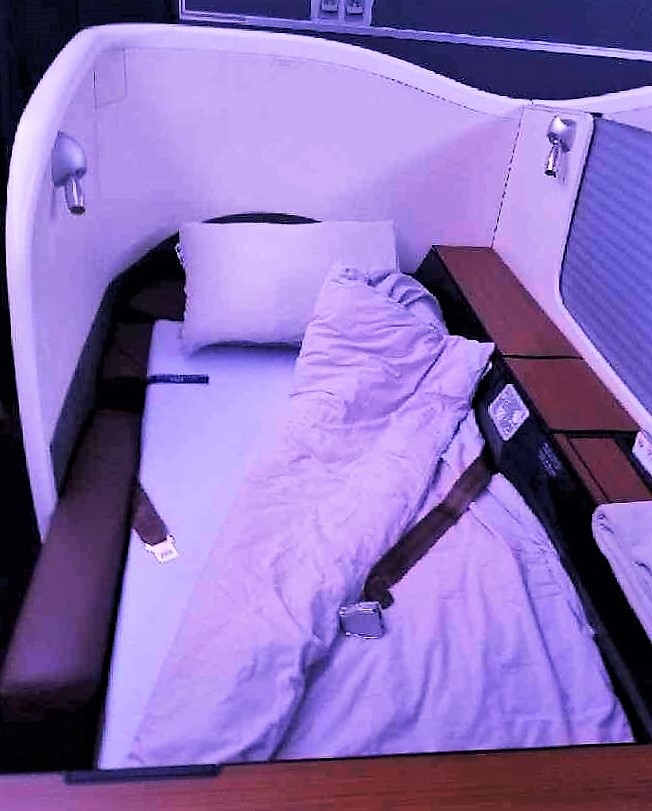



wowlooksfun
LikeLiked by 1 person
Truly was. Thanks for following
LikeLike
A very comprehensive review indeed! Thanks I felt like i was almost in first class JAL for a few moments. You must have really worked all the different ways to accrue your points! I think it must be easier in the States than here. I currently am closing in on 400,000 Qantas points and hope that ill get some real value of them, probably in 2023 with some luck with Covid and all. Hoping to travel overseas next year once but will use my travel credit on my Qantas Amex Ultimate card for that. It’s a real sense of reward I expect when you redeem for FIRST CLASS. Especially on a twelve hour flight. These are the flights where going business or first really makes a difference, which is how I’m hoping to strategically use my points in the future as I am happy to go economy for flights that arent so long. And if you can get a free seat next to you economy is not too bad. I remember a very comfy flight in 2019 with Air Astana. Great airline very under patronised, i wasnt complaining about all the free seats though! JAL I have wanted to use for years, but I dont know, despite a number of journeys to and from Japan I’ve never flown them. Air Asia a few times – so saving a bit of money I guess. Thanks for sharing!
LikeLiked by 1 person
That is a really nice stash of miles Andy! Even though we haven’t been able to travel, at least our mileage balances have been able to grow during the pandemic. I’m not familiar with the Qantas award charts but bet there is a lot of value you can get with those miles, including first class on Qantas and other Oneworld carriers. Qantas has outstanding first class lounges. Credit card sign-up bonuses for personal and small business cards (a blog counts, there is no requirement that the business be profitable) and transfers from Marriott are the primary ways I earn airline miles. I agree about the best ways to use the miles and the luxury of sitting next to an empty seat in economy. With all of the restrictions on international air travel, having an empty seat in economy is not that hard now. Thanks as always for your contributions to the post!
LikeLike
wow! what a flight. I think my favorite feature would be the free wifi. I know, kind of sad. And how nice that they gave you access to the suite next to you…
LikeLiked by 1 person
Good choice! I almost never pay for inflight wifi so being connected in the air was nice. I could check WP stats.😊
LikeLiked by 1 person
that’s what I would be doing 🙂
plus checking the price of the latest cyrptokitty…
LikeLiked by 1 person
Greece is open.
LikeLiked by 1 person
another blogger has shared some of her photos from a recent trip to Greece. I’ve never been there, but it looks wonderful…
LikeLiked by 1 person
I’m sure you’d really appreciate the history, scenery and food. The more dependent a country is on tourism, the harder they try to accommodate international travel.
LikeLiked by 1 person
you make it sound quite appealing!
LikeLike
The article is so well-written that I found myself not noticing a feeling creeping up on me of the Occupy 1% movement. You detail in loving depth a lifestyle I have never known and that I will have to use real ability to reach. There are people who would fuck you up real bad if they had a chance to get to you, because of the opulent lifestyle you seem to lead. Still, I’m not a Communist in the waiting. I’m glad you’re around, Salsa.
LikeLiked by 1 person
Being treated like a king for a day (more like 12 hours) is a blast. I’m proud of being able to scrape together enough airline miles to enjoy an experience like this. Some may be incensed that a Black and can do it. Too bad for them. Nothing new really.
LikeLike
The dining experience looks amazing. I love the simple elegance of Japanese cuisine. I was happy to see the non-alcoholic drinks list because I very rarely imbibe.
LikeLiked by 2 people
Japanese food is elegant in its presentation and seems so healthy, at least compared to what I usually eat. I can’t resist trying some of the exotic and expensive alcoholic beverages that are served in first class and business class and which I have little exposure to at home. Port wine is a beverage I was introduced to on a plane. I always try it now if it is served on a flight.
LikeLiked by 1 person
This wonderful post brought back memories of my Japan Airlines flight (only Business Class) from Narita (Tokyo) to Dallas,TX, at the end of my 70-day trip around the world as a first-time solo traveler when I retired in 2019. I didn’t have miles and used cash to pay for Business Class on each flight, as a gift to myself for retiring and for my upcoming 60th birthday. One of the things I enjoyed the most was being able to sip the $300 Japanese whisky that had been sold out in stores. Your First Class experience sounds divine!
LikeLiked by 2 people
Japan Airlines business class is a treat, too. I tried Japan Airlines Japanese whiskey on another flight. It is strong. If I’d known it cost $300/bottle, I would have had more. 😉 Thanks for cluing me in.
LikeLike
You poor dear, I’m sorry for the indignities you had to experience so you could write this blog post. 😉 Sounds lovely in every respect.
LikeLiked by 2 people
I’m more than willing to sacrifice like this on behalf of loyal readers.🤣 I deserve a medal, right?
LikeLiked by 1 person
Definitely, which cheek should we pin it on? LOL.
LikeLiked by 2 people
Oh my! Well on second thought, a nice letter of commendation will do. 😄
LikeLike
Good answer. 👍👍👍
LikeLiked by 1 person
Looks like a great first class flight., great food too and perfect seating.
LikeLiked by 2 people
The food and booze was a real treat. Thanks for stopping to check out the post.
LikeLiked by 1 person
Wow!!! I bet you big smile never left your face the whole flight 🙂 Not sure about the bidet on the flight, seems like it could be messy, although I’ve never used one so I’m just guessing haha
LikeLiked by 2 people
You’re right about the big smile! The bidet helps cleanliness, and the Japanese seem to be all about clean. 😀
LikeLike
That’s a great answer! 😊 Thank you for taking the time to read and comment. I hope you have a great Holiday Season!
LikeLiked by 1 person
I think I would have enjoyed the whole flight. Everything looks great with high standards of quality. Thank you for sharing your flying experience with Japan Airlines!
LikeLiked by 1 person